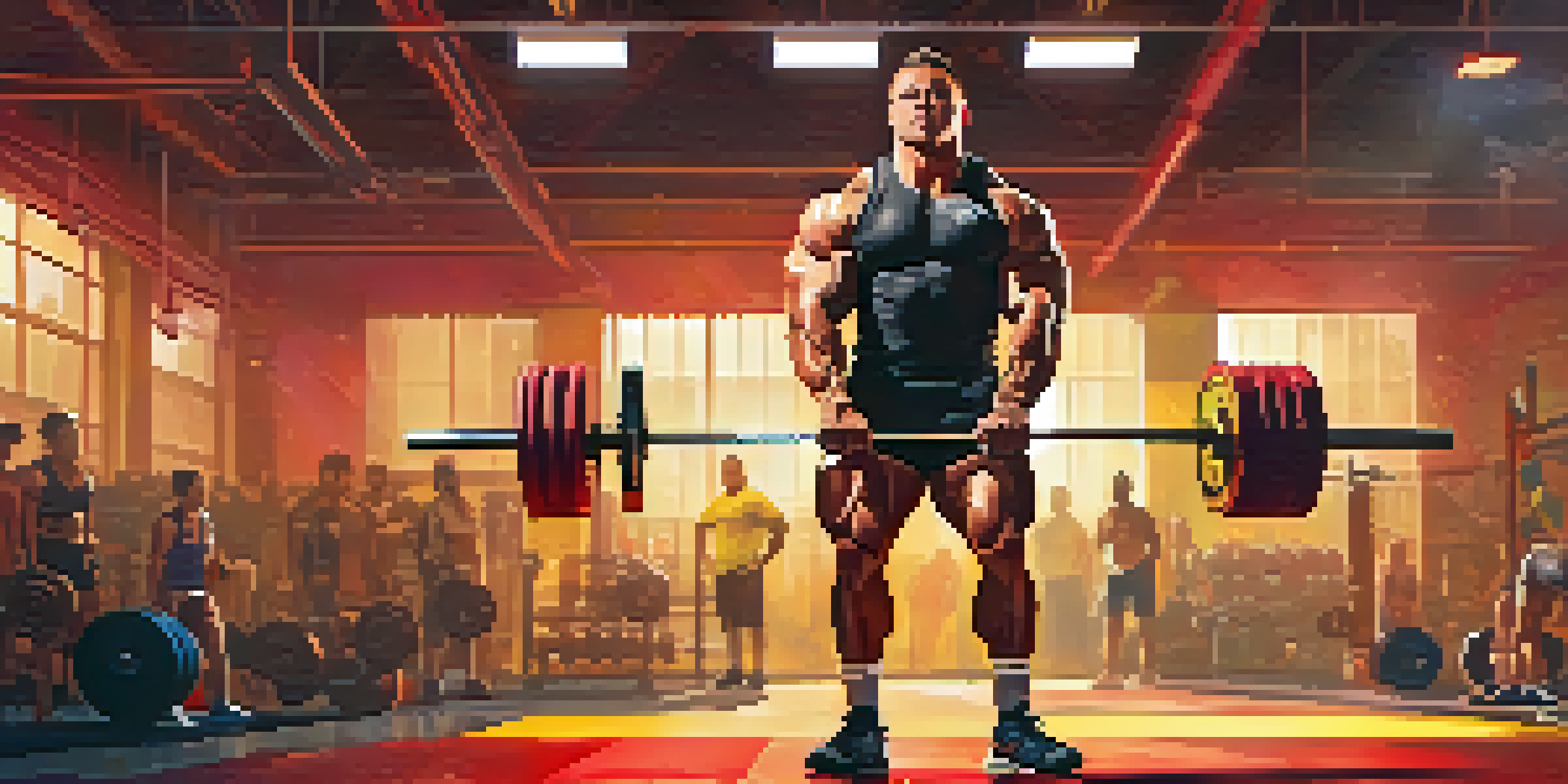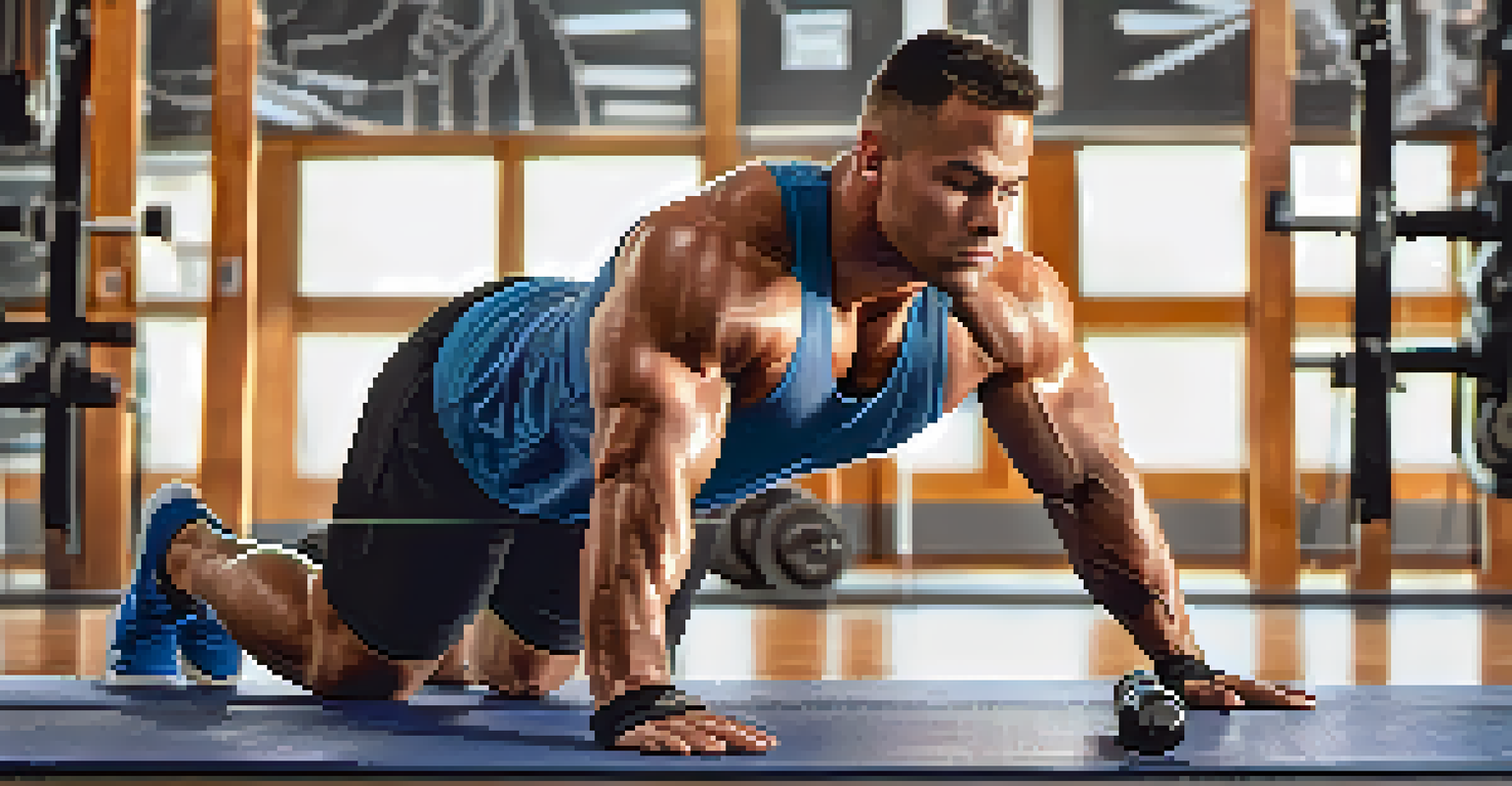Essential Cross-Training Exercises for Powerlifting Success

Understanding Cross-Training in Powerlifting
Cross-training is a concept that involves incorporating various exercises into your routine to improve overall performance. For powerlifters, this means engaging in workouts that enhance strength, flexibility, and endurance, ultimately translating to better lifts. It's like adding seasoning to a dish; while the main ingredient is vital, the right spices can elevate its flavor.
The more you sweat in training, the less you bleed in battle.
By diversifying your training regimen, you can prevent plateaus, reduce the risk of injury, and keep workouts interesting. Consider it a way to strengthen not just your muscles but also your mental approach to training. When you mix it up, you’re less likely to become bored or burnt out.
Incorporating cross-training can also help address muscle imbalances, ensuring that all muscle groups are well-developed. This approach is especially beneficial for powerlifters, as it prepares the body for the demands of heavy lifting and can lead to greater success in competitions.
The Importance of Mobility Work
Mobility work is essential for powerlifters as it enhances joint function and flexibility. Think of your joints as hinges; if they’re stiff and rusty, they won’t move as smoothly. Incorporating dynamic stretches and mobility drills into your routine can help maintain a full range of motion, which is crucial for executing lifts safely and effectively.

Mobility exercises can include movements like hip openers, thoracic spine rotations, and ankle mobility drills. These exercises prepare your body for the dynamic movements of lifting, reducing the risk of injury and improving your overall lifting form. Imagine trying to lift a heavy weight with tight muscles; it’s not just uncomfortable, it’s risky.
Embrace Cross-Training Benefits
Incorporating diverse exercises prevents plateaus, reduces injury risk, and enhances overall strength and endurance.
By prioritizing mobility, you create a strong foundation for your powerlifting journey. Over time, improved mobility can translate to more weight on the bar and better performance in competitions, making it a must-have in your cross-training arsenal.
Incorporating Olympic Lifts for Powerlifting
Olympic lifts, such as the snatch and clean and jerk, are fantastic for developing explosive power and strength. While they may seem intimidating, these lifts can significantly enhance your performance in the squat, bench press, and deadlift. They’re like a booster shot for your powerlifting—adding speed and agility to your strength training.
Strength does not come from physical capacity. It comes from an indomitable will.
These lifts require coordination, balance, and technique, which can translate well into your powerlifting lifts. Practicing Olympic lifts can improve your overall athleticism, making you a more versatile lifter. Plus, they add a fun challenge to your workouts, breaking the monotony of traditional powerlifting routines.
Incorporating Olympic lifts doesn’t mean you have to abandon your powerlifting focus; rather, it complements your main lifts by promoting muscle activation and improving neuromuscular efficiency. As you become more proficient, you may notice improvements in your strength and confidence during your powerlifting sessions.
The Role of Accessory Exercises
Accessory exercises are targeted movements that support your main lifts by strengthening specific muscle groups. Think of them as the side dishes to your main course; they provide essential nutrients that enhance your overall performance. Exercises like rows, lunges, and tricep extensions can help build the muscles that contribute to your squat, bench, and deadlift.
These exercises not only help in improving your lifting technique but also assist in muscle recovery and balance. By working on weak points, you can prevent injuries and promote muscle growth, ultimately leading to better lift performance. It’s all about building a strong support system for your main lifts.
Mobility Work is Essential
Prioritizing mobility exercises improves joint function and flexibility, which is crucial for safe and effective lifting.
Incorporating a variety of accessory exercises into your routine can provide a comprehensive workout that targets all aspects of powerlifting. This well-rounded approach ensures that you’re not just strong in one lift but are developing as a complete athlete.
Strengthening Core with Cross-Training
A strong core is crucial for any powerlifter, as it stabilizes the body during heavy lifts. Core exercises, such as planks, hanging leg raises, and medicine ball throws, enhance your overall strength and balance. Think of your core as the trunk of a tree; a sturdy trunk supports the entire structure, allowing it to withstand heavy winds.
By incorporating core training into your cross-training regimen, you can improve your lifting posture and reduce the risk of injury. A strong core helps maintain proper form during lifts, which is essential for maximizing performance. Imagine trying to lift without a solid foundation; it’s much harder and riskier.
Regular core training not only enhances your powerlifting but also improves your overall athletic performance. As you build core strength, you’ll likely notice improved stability and control in your movements, making you a more effective lifter in the long run.
Cardio's Role in Powerlifting Success
While powerlifting primarily focuses on strength, incorporating cardio can enhance your conditioning and recovery. Think of cardio as your body’s maintenance routine; it keeps your heart healthy and improves blood flow, which aids in muscle recovery. Activities like cycling, rowing, or even brisk walking can fit seamlessly into your training schedule.
Incorporating cardio doesn’t mean sacrificing strength gains; rather, it complements your training by improving your stamina during lifts. This added endurance can help you push through those last tough reps, making a significant difference in your performance. It’s like having a reserve tank that you can draw from when the going gets tough.
Recovery is Key to Progress
Active recovery and rest days are vital for muscle repair and long-term success in powerlifting.
Balancing cardio with your powerlifting routine can also help with weight management and overall health. By maintaining a healthy cardiovascular system, you’ll not only feel better but also perform better in your lifting sessions, leading to greater success in the sport.
The Benefits of Recovery and Rest Days
Recovery is often overlooked in the realm of powerlifting, yet it's vital for progress. Just like a plant needs time to grow after being watered, your muscles need time to recover after intense training sessions. Incorporating active recovery days, like light stretching or yoga, can help alleviate soreness and promote flexibility.
Rest days are just as important; they allow your muscles to repair and grow stronger. Think of them as the pause button on your workout journey; without them, you risk burnout and injury. It’s essential to listen to your body and give it the downtime it deserves.

By prioritizing recovery and rest, you create a sustainable training routine that can lead to long-term success in powerlifting. This balance between hard work and rest ensures that you’re not just lifting weights but also building a resilient body capable of handling the demands of the sport.